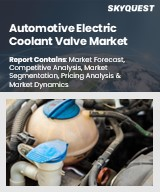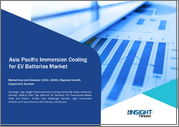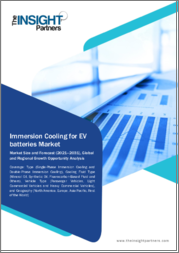
|
시장보고서
상품코드
1419700
EV 배터리 팩 냉각 시스템 시장 : 세계 및 지역별 분석(2023-2033년)EV Battery Pack Cooling System Market: A Global and Regional Analysis, 2023-2033 |
||||||
EV 배터리 팩 냉각 시스템 시장 규모는 2023년 29억 3,000만 달러에 달할 것으로 예상됩니다.
EV 배터리 팩 냉각 시스템 시장은 2033년까지 15.39%의 CAGR로 성장하여 122억 8,000만 달러에 달할 것으로 예상되며, 전기차 수요 증가로 인해 액체 냉각, 적응형 제어, 급속 충전 기술, 친환경 솔루션 등 기술 혁신이 촉진되고 있습니다. OEM과 공급업체 간의 협력과 규제 변화로 인해 이 역동적인 시장은 배터리 성능과 안전성을 최적화하기 위한 안정적이고 효율적인 냉각에 대한 관심이 더욱 높아지면서 더욱 역동적인 시장으로 발전하고 있습니다.
| 주요 시장 통계 | |
|---|---|
| 예측 기간 | 2023-2033년 |
| 2023년 평가 | 29억 3,000만 달러 |
| 2033년 예측 | 122억 8,000만 달러 |
| CAGR | 15.39% |
EV 배터리 팩 냉각 시스템은 전기자동차 배터리 팩의 온도를 관리하고 조정하기 위해 설계된 구성요소와 메커니즘의 통합 시스템입니다. 주요 목적은 배터리의 최적 작동 온도를 유지하여 효율적인 성능, 수명 및 안전을 보장하는 것입니다. EV 배터리 팩 냉각 시스템은 배터리 성능, 수명 및 안전에 영향을 미치는 과열과 같은 온도 관련 문제를 줄이는 데 중요한 역할을합니다. 온도를 효과적으로 관리함으로써 이 시스템은 전기자동차 배터리의 최적의 기능과 수명을 보장합니다.
EV 배터리 팩 냉각 시스템은 EV용 배터리의 최적의 성능, 안전성 및 수명을 보장하는 중요한 구성요소입니다. 배터리 팩의 온도 변동을 관리하고 과열을 방지하여 효율적인 작동을 보장합니다. 수냉식 또는 공냉식 시스템을 채택하여 배터리 수명을 연장하고, 주행거리를 늘리며, 빠른 충전을 위해 온도를 조절합니다. 재료, 열 관리 및 AI 구동 기술의 발전으로 이러한 시스템은 지속적으로 개선되고 있습니다. 급성장하는 전기차 시장에서 이러한 냉각 시스템은 EV의 성능, 안전성 및 신뢰성을 유지하는 데 매우 중요한 역할을 하며, 자동차 산업의 기술 혁신과 시장 성장을 촉진하고 있습니다.
EV 배터리 팩 냉각 시스템 시장이 산업에 미치는 영향은 자동차 제조, 기술 개발 및 지속가능한 이동성에 영향을 미칩니다. 이러한 발전은 열 관리의 기술 혁신을 촉진하고 더 안전하고 효율적인 전기자동차를 육성합니다. 이는 자동차 제조업체와 냉각 시스템 공급업체 간의 협력을 촉진하고, 제조 표준을 개선하며, 연구 개발의 한계를 뛰어넘을 수 있습니다. 또한, 전문 엔지니어링 및 생산 부문의 일자리 창출을 촉진하여 보다 광범위한 전기 모빌리티 생태계를 지원합니다. 또한, 친환경적이고 효율적인 냉각 솔루션에 대한 관심은 세계 지속가능성 목표에 부합하고 광범위한 산업 관행에 영향을 미치며 친환경 자동차 기술을 촉진합니다.
이 보고서는 세계 EV 배터리 팩 냉각 시스템 시장에 대해 조사했으며, 시장 개요와 함께 차량 유형별, 추진 유형별, 시스템 유형별, 지역별 동향, 시장 진입 기업 개요 등의 정보를 전해드립니다.
목차
주요 요약
범위와 정의
제1장 시장
- 동향 : 현재 및 향후의 영향 평가
- 공급망 개요
- 연구개발 리뷰
- 규제 상황
- 주요 세계적 사건의 영향 분석 - COVID-19
- 시장 역학 : 개요
- 효과적인 냉각 시스템의 중요성
제2장 용도
- 용도 세분화
- 용도 개요
- EV 배터리 팩 냉각 시스템 시장(차종별)
- EV 배터리 팩 냉각 시스템 시장(추진 유형별)
제3장 제품
- 제품 세분화
- 제품 개요
- EV 배터리 팩 냉각 시스템 시장(시스템 유형별)
제4장 지역
- 지역별 개요
- 성장 촉진요인과 억제요인
- 북미
- 유럽
- 아시아태평양
- 기타 지역
제5장 시장 - 경쟁 벤치마킹과 기업 개요
- 다음 프론티어
- 지리적 평가
- Boyd Corporation
- Dana Limited
- E-MERSIV
- Hanon Systems
- Kreisel Electric
- MAHLE GmbH
- Miba AG
- Modine Manufacturing Company
- RIGID HVAC
- TotalEnergies
- Valeo
- Vikas Group
- VOSS Automotive, Inc.
- Webasto Group
- XING Mobility
제6장 조사 방법
ksm 24.02.13“The Global EV Battery Pack Cooling System Market Expected to Reach $12.28 Billion by 2033.”
EV Battery Pack Cooling System Market Overview
The EV battery pack cooling system market was valued at $2.93 billion in 2023, and it is expected to grow at a CAGR of 15.39% and reach $12.28 billion by 2033. The EV battery pack cooling system market thrives due to rising electric vehicle demand, driving innovations in liquid cooling, adaptive controls, fast-charging tech, and eco-friendly solutions. OEM-supplier collaborations and regulatory shifts further shape this dynamic market, focusing on reliable, efficient cooling for optimal battery performance and safety.
| KEY MARKET STATISTICS | |
|---|---|
| Forecast Period | 2023 - 2033 |
| 2023 Evaluation | $2.93 Billion |
| 2033 Forecast | $12.28 Billion |
| CAGR | 15.39% |
Introduction of EV Battery Pack Cooling System
EV battery pack cooling system is the integrated system of components and mechanisms designed to manage and regulate the temperature within the battery pack of an electric vehicle. Its primary objective is to maintain optimal operating temperatures for the batteries, ensuring efficient performance, longevity, and safety. The EV battery pack cooling system plays a crucial role in mitigating temperature-related issues such as overheating, which can affect battery performance, lifespan, and safety. By managing temperatures effectively, this system ensures the optimal functioning and longevity of the batteries in electric vehicles.
Market Introduction
The EV battery pack cooling system is a critical component ensuring optimal performance, safety, and longevity of electric vehicle batteries. It manages temperature fluctuations within the battery pack, preventing overheating and ensuring efficient operation. By employing liquid or air-cooled systems, it regulates temperatures to extend battery life, enhance driving range, and enable faster charging. Advancements in materials, thermal management, and AI-driven technologies continuously improve these systems. With the burgeoning electric vehicle market, these cooling systems play a pivotal role in sustaining EV performance, safety, and reliability, fostering innovation and market growth in the automotive industry.
Industrial Impact
The EV battery pack cooling system market's industrial impact extends across automotive manufacturing, technology development, and sustainable mobility. Its advancements drive innovation in thermal management, fostering safer and more efficient electric vehicles. This spurs collaborations between automakers and cooling system suppliers, elevating manufacturing standards and pushing R&D boundaries. Additionally, it fuels job creation in specialized engineering and production sectors, supporting the broader electric mobility ecosystem. Moreover, the focus on eco-friendly and efficient cooling solutions aligns with global sustainability goals, influencing broader industrial practices and promoting greener automotive technologies.
The key players operating in the EV battery pack cooling system market include Boyd Corporation, Dana Limited, E-MERSIV, Hanon Systems, Kreisel Electric, MAHLE GmbH, Miba AG, Modine Manufacturing Company, RIGID HVAC, TotalEnergies, Valeo, Vikas Group, VOSS Automotive, Inc., Webasto Group, and XING Mobility, among others. These companies are focusing on strategic partnerships, collaborations, and acquisitions to enhance their product offerings and expand their market presence.
Market Segmentation:
Segmentation 1: by Vehicle Type
- Passenger Vehicle
- Commercial Vehicle
Passenger Vehicle to Dominate the EV Battery Pack Cooling System Market (by Vehicle Type)
Passenger vehicles make up a significantly larger portion of the overall automotive market compared to commercial vehicles. This sheer volume contributes to a larger demand for EV battery pack cooling systems in the passenger vehicle segment. Consumer interest in and adoption of electric passenger vehicles have been stronger than that of electric commercial vehicles. Factors such as cost savings, environmental consciousness, and government incentives have driven this demand. The focus on developing advanced cooling systems has primarily been directed toward passenger vehicles due to their higher market share. Manufacturers often prioritize R&D efforts on passenger EVs to improve efficiency, range, and performance. All this is expected to drive the EV battery pack cooling system market during the forecast period 2023-2033.
Segmentation 2: by Propulsion Type
- Battery Electric Vehicle
- Hybrid Electric Vehicle
- Plug-in Hybrid Electric Vehicle
Battery Electric Vehicle to Dominate the EV Battery Pack Cooling System Market (by Propulsion Type)
Battery electric vehicle (BEV) is expected to continue dominating the EV battery pack cooling system market. BEVs have been at the forefront of the electric vehicle revolution. They solely rely on battery power for propulsion, making their cooling system a crucial component for efficient and safe operation. Efficient cooling systems directly impact the range and performance of BEVs. Better thermal management enhances battery life, extends driving range, and allows for faster charging, making these systems pivotal for BEV success. While plug-in hybrid electric vehicles (PHEVs) and hybrid electric vehicles (HEVs) also utilize batteries and require cooling systems, their reliance on internal combustion engines alongside electric power might result in less stringent cooling system requirements compared to BEVs.
Segmentation 3: by System Type
- Air Cooling System
- Liquid Cooling Systems
Liquid Cooling System to be Dominant in the EV Battery Pack Cooling System Market (by System Type)
Liquid cooling systems are highly efficient at managing temperature fluctuations within the battery pack. They can effectively dissipate heat from the cells, ensuring optimal operating conditions and enhancing the overall longevity and performance of the battery. For electric vehicles requiring high power output or performance (such as many passenger EVs), liquid cooling is often preferred due to its ability to manage higher heat loads more effectively compared to air-cooled systems. As battery capacities increase, such as in long-range EVs, liquid cooling becomes more crucial. It helps distribute the cooling effect evenly across a larger battery pack, maintaining consistent temperatures throughout. Ongoing advancements in liquid cooling systems, including the development of more efficient coolant materials and designs, have further reinforced their dominance in the market.
Segmentation 4: by Region
- North America: U.S., Canada, and Mexico
- Europe: Germany, France, Italy, U.K., and Rest-of-Europe
- Asia-Pacific: China, Japan, South Korea, India, and Rest-of-Asia-Pacific
- Rest-of-the-World: Middle East and Africa and South America
The Asia-Pacific region is a dominant force in the EV battery pack cooling system market. This was primarily due to the robust presence of EV manufacturing hubs, technological advancements, and supportive government policies promoting electric vehicle adoption in countries such as China, Japan, South Korea, India, and Rest-of-Asia-Pacific. Asia-Pacific nations, particularly China, have been leading in EV production. Their expertise in manufacturing and economies of scale have enabled them to lead in producing battery packs and associated cooling systems. Continuous innovation in cooling systems for EV batteries was a key factor. Asian countries, with their strong R&D focus, have been at the forefront of developing more efficient and effective cooling technologies. Substantial government incentives, subsidies, and regulations supporting the adoption of electric vehicles have played a significant role in propelling the market in this region.
Recent Developments in the EV Battery Pack Cooling System Market
- In August 2023, Boyd Corporation collaborated with E-valucon and developed a liquid-to-air cooling system tailored for DC Fast Charging (DCFC) cables and connectors, facilitating rapid and secure charging. The use of eco-friendly coolants underscores the environmentally conscious nature of the liquid-cooled technology.
- In October 2022, TotalEnergies and Valeo disclosed their collaboration agreement to pioneer an advanced method for cooling electric vehicle batteries. This groundbreaking approach involves utilizing an exceptionally high-performance dielectric fluid.
- In September 2021, MAHLE GmbH introduced an innovative cooling system designed specifically for batteries. Cooling poses a significant challenge, particularly in rapidly charging battery-powered electric vehicles. To address this, the automotive supplier based in Stuttgart has embraced immersion cooling as a pivotal technology.
Demand - Drivers, Limitations, and Opportunities
Market Demand Drivers: Enhancing the Driving Range of Electric Vehicles
One of the biggest barriers to the adoption of electric cars is range anxiety. Although the EV driving range has significantly expanded in recent years, there is still a common perception that these vehicles would run out of battery and leave their passengers stranded. Commercial fleets are likewise hesitant to adopt electric vehicles, citing range anxiety as a reason. Fleet owners worry that EVs will result in decreased productivity and higher maintenance expenses. In recent years, various OEMs have invested in developing EVs with a greater driving range, which is expected to drive the adoption of EVs
Several companies have started developing fluids and coolants for electric vehicles that will be used to increase battery power and eliminate range anxiety. These battery cooling pack systems will contribute to increased battery capacity and cell longevity, thereby expected to drive the EV battery pack cooling system market over the forecast period from 2023 to 2033.
Market Challenges: Higher Cost of EV Battery Pack Cooling System
High cost has been a key deterrent to increasing the sales of electric vehicles. Many promoters of electric vehicles have often compared the cost of regular gasoline with eGallon to showcase the cost savings with an electric vehicle. eGallon is defined by the U.S. Department of Energy as the cost of powering a vehicle through electricity. As of June 2022, eGallon has become cheaper by $3.26 as compared to gasoline. Also, as EVs have fewer moving parts, they incur less maintenance costs than internal combustion engine vehicles. These benefits make EVs smart long-term investments.
Developing intricate cooling systems that efficiently manage heat while being compatible with various battery designs adds complexity and raises production costs. Moreover, incorporating cutting-edge cooling technology, such as liquid cooling or intelligent thermal management, involves higher material and R&D expenses, contributing to elevated system costs. The cost of scaling production to meet the rising demand for electric vehicles can also drive up the expenses related to manufacturing cooling systems. The higher cost of these systems might reflect in the overall vehicle price, impacting consumer affordability and potentially deterring some from purchasing electric vehicles.
To mitigate this restraint in the EV battery pack cooling system market, industry efforts focus on continuous innovation to streamline production processes, reduce material costs, and optimize system designs. Standardization, economies of scale, and advancements in manufacturing techniques can help alleviate the cost burden, making EV battery pack cooling systems more accessible and affordable for widespread electric vehicle adoption.
Market Opportunities: Stringent Regulations by Government Bodies
Stringent regulations imposed by government bodies can present a significant opportunity in the EV battery pack cooling system market. These regulations often aim to enhance safety standards, improve efficiency, and reduce environmental impact. In the context of electric vehicle (EV) battery packs, stricter regulations might require better thermal management systems to ensure batteries operate within optimal temperature ranges, thereby improving their performance and lifespan.
This creates an opportunity for companies in the EV battery pack cooling system market to innovate and develop more efficient and reliable solutions that comply with these regulations. By meeting or exceeding these standards, such companies can gain a competitive edge, attract more customers, and establish themselves as leaders in the market.
Stringent regulations ensure that cooling systems meet safety and performance benchmarks, enhancing consumer trust in electric vehicles and their associated components. Compliance with regulations encourages the adoption of electric vehicles by boosting confidence in their safety and reliability, subsequently driving the demand for efficient and compliant cooling systems. Moreover, international regulatory alignment can facilitate the global adoption of standardized cooling systems, streamlining market entry into different regions with similar requirements.
How can this report add value to an organization?
Product/Innovation Strategy: The product segment helps the reader understand the different applications of the EV battery pack cooling system products available based on vehicle type (passenger vehicle and commercial vehicle), propulsion type (battery electric vehicle, hybrid electric vehicle, and plug-in hybrid electric vehicle), system type (air cooling system and liquid cooling system). The market is poised for significant expansion with ongoing technological advancements, increased investments, and growing awareness of the importance of cooling systems. Therefore, the EV battery pack cooling system business is a high-investment and high-revenue generating model.
Growth/Marketing Strategy: The EV battery pack cooling system market has been growing at a rapid pace. The market offers enormous opportunities for existing and emerging market players. Some of the strategies covered in this segment are mergers and acquisitions, product launches, partnerships and collaborations, business expansions, and investments. The strategies preferred by companies to maintain and strengthen their market position primarily include product development.
Competitive Strategy: The key players in the EV battery pack cooling system market analyzed and profiled in the study include EV battery pack cooling system manufacturers that develop, maintain, and market EV battery pack cooling systems. Additionally, a comprehensive competitive landscape such as partnerships, agreements, and collaborations are expected to aid the reader in understanding the untapped revenue pockets in the market.
Research Methodology
Factors for Data Prediction and Modeling
- The scope of the EV battery pack cooling system market report has been focused on electric vehicles only.
- In the vehicle type segment, two-wheelers and three-wheelers are not considered in the scope, and only passenger cars are included in the passenger vehicle segment. Moreover, in the commercial vehicle segment, buses and trucks are considered under the scope of the report.
- The base currency considered for the market analysis is US$. Currencies other than the US$ have been converted to the US$ for all statistical calculations, considering the average conversion rate for that particular year.
- The currency conversion rate has been taken from the historical exchange rate of the Oanda website.
- Nearly all the recent developments from January 2020 to December 2023 have been considered in this research study.
- The information rendered in the report is a result of in-depth primary interviews, surveys, and secondary analysis.
- Where relevant information was not available, proxy indicators and extrapolation were employed.
- Any economic downturn in the future has not been taken into consideration for the market estimation and forecast.
- Technologies currently used are expected to persist through the forecast with no major breakthroughs in technology.
Market Estimation and Forecast
This research study involves the usage of extensive secondary sources, such as certified publications, articles from recognized authors, white papers, annual reports of companies, directories, and major databases to collect useful and effective information for an extensive, technical, market-oriented, and commercial study of the global EV battery pack cooling system market.
The process of market engineering involves the calculation of the market statistics, market size estimation, market forecast, market crackdown, and data triangulation (the methodology for such quantitative data processes is explained in further sections). The primary research study has been undertaken to gather information and validate the market numbers for segmentation types and industry trends of the key players in the market.
Primary Research
The primary sources involve industry experts from the EV battery pack cooling system market and various stakeholders in the ecosystem. Respondents such as CEOs, vice presidents, marketing directors, and technology and innovation directors have been interviewed to obtain and verify both qualitative and quantitative aspects of this research study.
The key data points taken from primary sources Include:
- validation and triangulation of all the numbers and graphs
- validation of reports segmentation and key qualitative findings
- understanding the competitive landscape
- validation of the numbers of various markets for market type
- percentage split of individual markets for geographical analysis
Secondary Research
This research study of the EV battery pack cooling system market involves the usage of extensive secondary research, directories, company websites, and annual reports. It also makes use of databases, such as Hoovers, Bloomberg, Businessweek, and Factiva, to collect useful and effective information for an extensive, technical, market-oriented, and commercial study of the global market. In addition to the aforementioned data sources, the study has been undertaken with the help of other data sources and websites, such as IRENA and IEA.
Secondary research was done in order to obtain crucial information about the industry's value chain, revenue models, the market's monetary chain, the total pool of key players, and the current and potential use cases and applications.
The key data points taken from secondary research include:
- segmentations and percentage shares
- data for market value
- key industry trends of the top players of the market
- qualitative insights into various aspects of the market, key trends, and emerging areas of innovation
- quantitative data for mathematical and statistical calculations
Key Market Players and Competition Synopsis
The companies that are profiled have been selected based on inputs gathered from primary experts and analysing company coverage, product portfolio, and market penetration.
Some of the prominent companies in this market are:
|
|
Table of Contents
Executive Summary
Scope and Definition
1. Markets
- 1.1. Trends: Current and Future Impact Assessment
- 1.1.1. Trends: Overview
- 1.1.2. Rising Demand in Electric Vehicle Industry
- 1.1.3. Advancements in Battery Technology
- 1.2. Supply Chain Overview
- 1.2.1. Value Chain Analysis
- 1.2.2. Market Map
- 1.3. Research and Development Review
- 1.3.1. Patent Filing Trend (by Number of Patents, Country)
- 1.4. Regulatory Landscape
- 1.5. Impact Analysis for Key Global Events - COVID-19
- 1.6. Market Dynamics: Overview
- 1.6.1. Market Drivers
- 1.6.1.1. Enhancing the Driving Range of Electric Vehicles
- 1.6.1.2. Thermal Management in Electric Vehicles
- 1.6.1.3. Emerging Alternate Cooling Technology
- 1.6.2. Market Restraints
- 1.6.2.1. Higher Cost of EV Battery Pack Cooling System
- 1.6.2.2. Compatibility and Integration Issues
- 1.6.3. Market Opportunities
- 1.6.3.1. Stringent Regulations by Government Bodies
- 1.6.3.2. Gaining a Competitive Edge through Innovation
- 1.6.1. Market Drivers
- 1.7. Significance of Effective Cooling System
2. Application
- 2.1. Application Segmentation
- 2.2. Application Summary
- 2.3. EV Battery Pack Cooling System Market (by Vehicle Type)
- 2.3.1. Vehicle Type
- 2.3.1.1. Passenger Vehicle
- 2.3.1.2. Commercial Vehicle
- 2.3.1. Vehicle Type
- 2.4. EV Battery Pack Cooling System Market (by Propulsion Type)
- 2.4.1. Propulsion Type
- 2.4.1.1. Battery Electric Vehicle
- 2.4.1.2. Hybrid Electric Vehicle
- 2.4.1.3. Plug-in Hybrid Electric Vehicle
- 2.4.1. Propulsion Type
3. Products
- 3.1. Product Segmentation
- 3.2. Product Summary
- 3.3. EV Battery Pack Cooling System Market (by System Type)
- 3.3.1. System Type
- 3.3.1.1. Air Cooling System
- 3.3.1.2. Liquid Cooling System
- 3.3.1. System Type
4. Regions
- 4.1. Regional Summary
- 4.2. Drivers and Restraints
- 4.3. North America
- 4.3.1. Regional Overview
- 4.3.2. Driving Factors for Market Growth
- 4.3.3. Factors Challenging the Market
- 4.3.4. Application
- 4.3.5. Product
- 4.3.6. North America (by Country)
- 4.3.6.1. U.S.
- 4.3.6.2. Canada
- 4.3.6.3. Mexico
- 4.4. Europe
- 4.4.1. Regional Overview
- 4.4.2. Driving Factors for Market Growth
- 4.4.3. Factors Challenging the Market
- 4.4.4. Application
- 4.4.5. Product
- 4.4.6. Europe (by Country)
- 4.4.6.1. Germany
- 4.4.6.2. France
- 4.4.6.3. Italy
- 4.4.6.4. U.K.
- 4.4.6.5. Rest-of-Europe
- 4.5. Asia-Pacific
- 4.5.1. Regional Overview
- 4.5.2. Driving Factors for Market Growth
- 4.5.3. Factors Challenging the Market
- 4.5.4. Application
- 4.5.5. Product
- 4.5.6. Asia-Pacific (by Country)
- 4.5.6.1. China
- 4.5.6.2. Japan
- 4.5.6.3. South Korea
- 4.5.6.4. India
- 4.5.6.5. Rest-of-Asia-Pacific
- 4.6. Rest-of-the-World
- 4.6.1. Regional Overview
- 4.6.2. Driving Factors for Market Growth
- 4.6.3. Factors Challenging the Market
- 4.6.4. Application
- 4.6.5. Product
- 4.6.6. Rest-of-the-World (by Region)
- 4.6.6.1. Middle East and Africa
- 4.6.6.1. South America
5. Markets - Competitive Benchmarking & Company Profiles
- 5.1. Next Frontiers
- 5.2. Geographic Assessment
- 5.2.1. Boyd Corporation
- 5.2.1.1. Overview
- 5.2.1.2. Top Products/Product Portfolio
- 5.2.1.3. Top Competitors
- 5.2.1.4. Target Customers
- 5.2.1.5. Key Personnel
- 5.2.1.6. Analyst View
- 5.2.1.7. Market Share
- 5.2.2. Dana Limited
- 5.2.2.1. Overview
- 5.2.2.2. Top Products/Product Portfolio
- 5.2.2.3. Top Competitors
- 5.2.2.4. Target Customers
- 5.2.2.5. Key Personnel
- 5.2.2.6. Analyst View
- 5.2.2.7. Market Share
- 5.2.3. E-MERSIV
- 5.2.3.1. Overview
- 5.2.3.2. Top Products/Product Portfolio
- 5.2.3.3. Top Competitors
- 5.2.3.4. Target Customers
- 5.2.3.5. Key Personnel
- 5.2.3.6. Analyst View
- 5.2.3.7. Market Share
- 5.2.4. Hanon Systems
- 5.2.4.1. Overview
- 5.2.4.2. Top Products/Product Portfolio
- 5.2.4.3. Top Competitors
- 5.2.4.4. Target Customers
- 5.2.4.5. Key Personnel
- 5.2.4.6. Analyst View
- 5.2.4.7. Market Share
- 5.2.5. Kreisel Electric
- 5.2.5.1. Overview
- 5.2.5.2. Top Products/Product Portfolio
- 5.2.5.3. Top Competitors
- 5.2.5.4. Target Customers
- 5.2.5.5. Key Personnel
- 5.2.5.6. Analyst View
- 5.2.5.7. Market Share
- 5.2.6. MAHLE GmbH
- 5.2.6.1. Overview
- 5.2.6.2. Top Products/Product Portfolio
- 5.2.6.3. Top Competitors
- 5.2.6.4. Target Customers
- 5.2.6.5. Key Personnel
- 5.2.6.6. Analyst View
- 5.2.6.7. Market Share
- 5.2.7. Miba AG
- 5.2.7.1. Overview
- 5.2.7.2. Top Products/Product Portfolio
- 5.2.7.3. Top Competitors
- 5.2.7.4. Target Customers
- 5.2.7.5. Key Personnel
- 5.2.7.6. Analyst View
- 5.2.7.7. Market Share
- 5.2.8. Modine Manufacturing Company
- 5.2.8.1. Overview
- 5.2.8.2. Top Products/Product Portfolio
- 5.2.8.3. Top Competitors
- 5.2.8.4. Target Customers
- 5.2.8.5. Key Personnel
- 5.2.8.6. Analyst View
- 5.2.8.7. Market Share
- 5.2.9. RIGID HVAC
- 5.2.9.1. Overview
- 5.2.9.2. Top Products/Product Portfolio
- 5.2.9.3. Top Competitors
- 5.2.9.4. Target Customers
- 5.2.9.5. Key Personnel
- 5.2.9.6. Analyst View
- 5.2.9.7. Market Share
- 5.2.10. TotalEnergies
- 5.2.10.1. Overview
- 5.2.10.2. Top Products/Product Portfolio
- 5.2.10.3. Top Competitors
- 5.2.10.4. Target Customers
- 5.2.10.5. Key Personnel
- 5.2.10.6. Analyst View
- 5.2.10.7. Market Share
- 5.2.11. Valeo
- 5.2.11.1. Overview
- 5.2.11.2. Top Products/Product Portfolio
- 5.2.11.3. Top Competitors
- 5.2.11.4. Target Customers
- 5.2.11.5. Key Personnel
- 5.2.11.6. Analyst View
- 5.2.11.7. Market Share
- 5.2.12. Vikas Group
- 5.2.12.1. Overview
- 5.2.12.2. Top Products/Product Portfolio
- 5.2.12.3. Top Competitors
- 5.2.12.4. Target Customers
- 5.2.12.5. Key Personnel
- 5.2.12.6. Analyst View
- 5.2.12.7. Market Share
- 5.2.13. VOSS Automotive, Inc.
- 5.2.13.1. Overview
- 5.2.13.2. Top Products/Product Portfolio
- 5.2.13.3. Top Competitors
- 5.2.13.4. Target Customers
- 5.2.13.5. Key Personnel
- 5.2.13.6. Analyst View
- 5.2.13.7. Market Share
- 5.2.14. Webasto Group
- 5.2.14.1. Overview
- 5.2.14.2. Top Products/Product Portfolio
- 5.2.14.3. Top Competitors
- 5.2.14.4. Target Customers
- 5.2.14.5. Key Personnel
- 5.2.14.6. Analyst View
- 5.2.14.7. Market Share
- 5.2.15. XING Mobility
- 5.2.15.1. Overview
- 5.2.15.2. Top Products/Product Portfolio
- 5.2.15.3. Top Competitors
- 5.2.15.4. Target Customers
- 5.2.15.5. Key Personnel
- 5.2.15.6. Analyst View
- 5.2.15.7. Market Share
- 5.2.1. Boyd Corporation
6. Research Methodology
- 6.1. Data Sources
- 6.1.1. Primary Data Sources
- 6.1.2. Secondary Data Sources
- 6.1.3. Data Triangulation
- 6.2. Market Estimation and Forecast



















